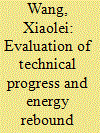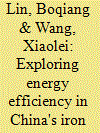|
|
|
Sort Order |
|
|
|
Items / Page
|
|
|
|
|
|
|
| Srl | Item |
| 1 |
ID:
185703


|
|
|
|
|
| Summary/Abstract |
The tiered electricity pricing (TEP) policy in China was implemented for 10 years. With the rapid economic growth and changing in residential consumption behavior, whether the initial design is still effective for electricity conservation and residential affordability is a worthy topic. By survey data of China Family Panel Studies project, this paper examined the policy effect of TEP from perspective of the threshold settings, long-term electricity conservation and residential affordability. Firstly, the Extended Linear Expenditure System was proposed to evaluate the basic needs of residents, and the results showed that the threshold value was still reasonable. Secondly, the long-term effect of TEP on electricity consumption for different tiered residents was estimated by DID method. Although the third-tier residents showed more obvious electricity-saving behaviors compared with the second-tier residents, the policy effect on residents’ electricity-saving behavior was weakening and the expected policy effect was gradually being released. Lastly, the further assessment of the residents' welfare loss and electricity expenditure showed that the policy reform was still within the affordable range of the residents. In order to maintain the effectiveness of the policy, the government should further optimize the TEP structure to promote residential electricity saving behavior.
|
|
|
|
|
|
|
|
|
|
|
|
|
|
|
|
| 2 |
ID:
162282


|
|
|
|
|
| Summary/Abstract |
As a pillar industry in China, the iron & steel sector have under through rapid growth and technical progress for decades. However, energy polices aiming at energy savings may not be as good as expected due to the existence of rebound effects. The motivation of the paper is to analysis the nexus between technical progress and energy rebound effects. Based on a three-input trans-log cost function model, we first estimate the share equation and the corresponding price elasticity for each input factor. Then, the rebound effect in China's iron & steel industry over 1985–2015 is evaluated through decomposing the energy prices. Empirical results show that: (1) The price elasticities of input factors are negative; (2) Energy/capital and energy/labor show substitute relationships; (3) The average energy rebound effect in the ISI is as high as 73.88%; (4) The energy rebound effect shows a downward trend before the 11th Five-year period and then an upward trend after that. Therefore, policies proposals of lowering the rebound effect should be placed not only on technical progress, but also on energy price reform by reducing energy subsidies and thus accelerating energy price marketization, so as to promote energy substitution, reduce energy rebound effect and produce further economic and environmental benefits.
|
|
|
|
|
|
|
|
|
|
|
|
|
|
|
|
| 3 |
ID:
132600


|
|
|
|
|
| Publication |
2014.
|
| Summary/Abstract |
The iron and steel industry is one of the major energy-consuming industries in China. Given the limited research on effective energy conservation in China×s industrial sectors, this paper analyzes the total factor energy efficiency and the corresponding energy conservation potential of China×s iron and steel industry using the excessive energy-input stochastic frontier model. The results show that there was an increasing trend in energy efficiency between 2005 and 2011 with an average energy efficiency of 0.699 and a cumulative energy conservation potential of 723.44 million tons of coal equivalent (Mtce). We further analyze the regional differences in energy efficiency and find that energy efficiency of Northeastern China is high while that of Central and Western China is low. Therefore, there is a concentration of energy conservation potential for the iron and steel industry in the Central and Western areas. In addition, we discover that inefficient factors are important for improving energy conservation. We find that the structural defect in the economic system is an important impediment to energy efficiency and economic restructuring is the key to improving energy efficiency.
|
|
|
|
|
|
|
|
|
|
|
|
|
|
|
|
| 4 |
ID:
168328


|
|
|
|
|
| Summary/Abstract |
The transport sector is a major source of oil consumption and CO2 emissions in China, however, due to the regulated pricing mechanism in China, the end-user oil price cannot reflect real market price and thus oil price distortion exists. Therefore, the main aim of this paper is to study the affecting mechanism of oil price distortion on CO2 emission mitigation. Firstly, the level of oil price distortion is evaluated and a dynamic trans-log cost function model is built to analyze the substitution relationship among energy products. Secondly, the own price elasticity and cross price elasticity for fuel demand are calculated based on provincial panel data of China's transport sector over 2004–2016. Finally, CO2 mitigation potentials are estimated by removing the impact of oil price distortion. Results show that: 1) there is positive oil price distortion over 2004–2016; 2) substitute relationship is observed between oil and coal, oil and electricity, and the substitution relationship is affected by factor substitution; 3) removing oil price distortion will reduce CO2 emissions of China's transport sector by 599 million tons in the studying period. Policies should focus removing the impact of oil price distortion, promoting electricity/oil substitution and promoting capital/energy substitution to mitigate CO2 emissions.
|
|
|
|
|
|
|
|
|
|
|
|
|
|
|
|
|
|
|
|
|